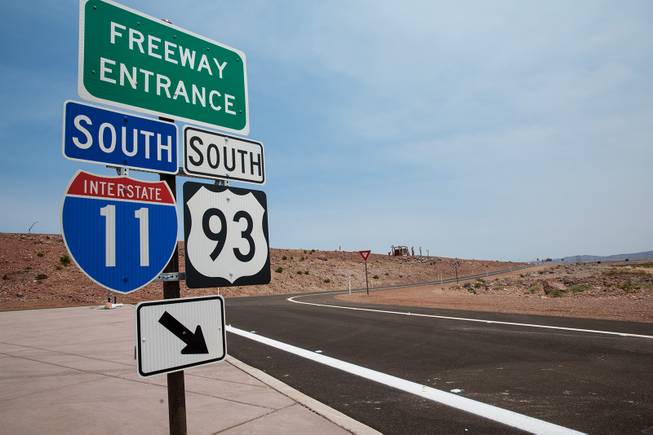
Interstate 11 celebrates it’s grand opening, allowing vehicles to use the newly finished highway to bypass Boulder City on their way to Arizona, Thursday Aug. 9, 2018.
Monday, Sept. 10, 2018 | 9 p.m.
The Arizona Department of Transportation continues to make plans for the fabled Interstate 11, announcing a $155 million investment into the stretch of highway from Phoenix to Las Vegas.
The plans, for what is now known as U.S. 93, have been in the making for years, with several more to go.
Meanwhile, the nerve-rattling, headache-inducing, traffic-clogged two-lane stretches from Tucson to Phoenix that are much of Interstate 10 aren't getting much thought.
The issue is that touted improvements to U.S. 93 are part of a larger plan to build a dedicated trade corridor between Mexico and Canada, running right through Arizona.
As part of the I-11 investment announcement, ADOT touted its commitment to reducing the number of miles where traffic is not on a four-lane divided highway between Phoenix and the Arizona-Nevada border down to 39 miles.
The five-year plan for U.S. 93 would widen an additional 11 miles to a four-lane divided highway and buy the land necessary to build a new U.S. 93 interchange with I-40 in Kingman.
But there was little mention of the southern leg of the I-11 route, which would connect Wickenberg and Nogales.
The exact route isn't defined and is part of an in-depth, prolonged study by ADOT, with a decision not expected until late 2019 or early 2020.
The cheapest alternative to building a new highway is what ADOT refers to as an "a no-build option" that would continue to route semi-trucks through existing roads, including I-10.
And while the goal of a three-lane divided Interstate 10 has been the dream of every Tucsonan driving to Phoenix for decades, ADOT has penciled in 2027 as when it will start widening the last section of I-10 along the Gila River Indian Community between Loop 202 and State Route 387.
An ADOT spokesperson said that while widening I-10 has long been a top long-term priority, the project has been delayed as the state wrestles with a sensitive agreement with tribal leaders, as well as setting aside the significant funding needed for the project.
So why did ADOT choose 93 over I-10?
On paper, both U.S. 93 and I-10 are considered part of the Interstate 11 project by the state.
I-10 is considerably busier, with annual daily traffic between Phoenix and Tucson near Eloy clocking in around 43,000 cars a day, according to ADOT. Annual daily traffic on U.S. 93 near Wickenberg hovers around 12,800 vehicles a day.
Crash data along the two stretches of highways wasn't readily available, but the former chair of the state's transportation board, Pima County Supervisor Steve Christy, said both roads are dangerous.
Christy, who left the board several years ago, said severe safety issues along U.S. 93 have been known for years, and the board looked high and low for funding sources to expand the mostly rural highway.
However, Christy said that funding shouldn't have come before widening Interstate 10.
"We are being knifed in the back," Christy said.
The stretch of I-10 that goes through the Gila River Indian Community is complicated, with both the tribe and the federal government at the table when discussing expansion plans, says Mike Hammond, who joined the board in 2015 representing Southern Arizona.
He said his first question when he joined the board three years ago was about the expansion of Interstate 10, and that he disagrees with Christy.
"I don't think Southern Arizona has been shortchanged," Hammond said.
Legal battles with the tribe related to the South Mountain Freeway have slowed the timetable for the I-10 expansion, Hammond said.
He said ADOT has reached out to the tribe to resolve the issues, but the tribe wanted to include the South Mountain Freeway expansion issues in its negotiations during an ongoing court battle.
Fast-tracking the project, Hammond said, is the best ADOT could do until an agreement is reached between the state, the federal government and the Gila River Indian Community.
Even after that agreement is reached, it will take years before construction can begin, as ADOT will still need to perform a lengthy environmental study and related engineering plans.
"It is the best ADOT can do," Hammond said.
